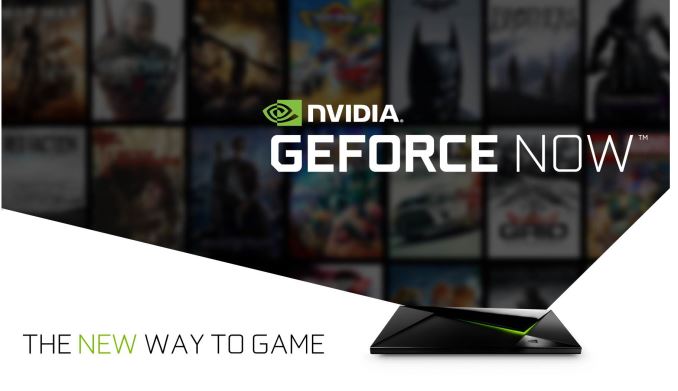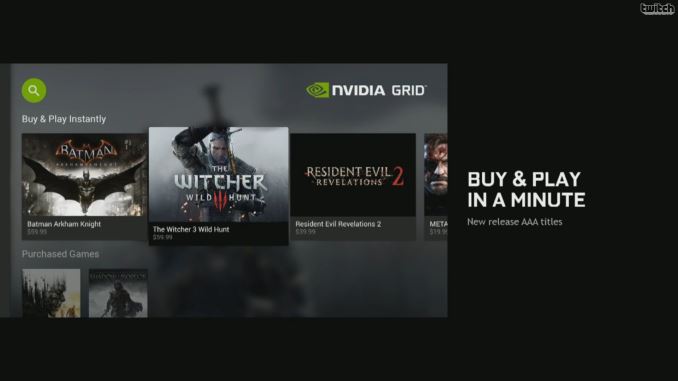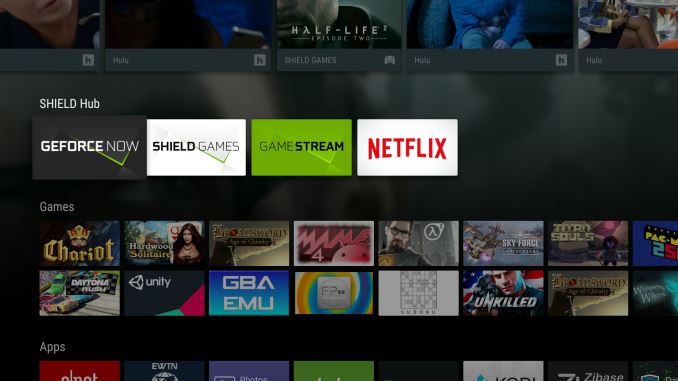NVIDIA's GeForce NOW - GRID Cloud Gaming Service Goes the Subscription Way
by Ganesh T S on September 30, 2015 9:00 AM EST- Posted in
- NVIDIA
- Shield
- Android TV
- Cloud Gaming

NVIDIA's GRID game streaming service was launched back in 2013 as a beta project. Over the last couple of years, they have added a number of features that bring together the capabilities of their data center GPUs and their Tegra SoCs. At GDC 2015, NVIDIA indicated that they would be promoting the GRID program from beta to a commercial service. The commercial service was originally slated to launch along with the SHIELD Android TV in May, but the launch kept getting pushed back.
Today, NVIDIA is announcing that the service is getting out of beta with a new tag - GeForce NOW. With widespread and reliable Internet connectivity, content consumption is going the streaming way - services such as Netflix, Spotify and Hulu boast a huge subscriber base. NVIDIA is hoping that GeForce NOW will become the de-facto service for consumers looking to stream games.
Game streaming is quite challenging compared to traditional media streaming - in addition to low latency real-time encoding on the server side, we also need the client user input to have minimal lag while getting reflected on the server side. Companies such as OnLive and Gaikai have tried to address this market with mixed success (getting bought out by Sony in 2015 and 2012 respectively).
However, from our limited time over the past two years with the GRID beta service, we have to say that the experience can be quite compelling - the gaming experience is instant without having to wait for multi-gigabyte downloads, and one has a huge library of games to choose from (similar to Netflix's library of movies). NVIDIA has been pushing hard to keep latency within reason - generally aiming for the equivalent of a console game at 30fps - and while network quality and location are paramount here, reasonably low latency is attainable if you live close enough to one of NVIDIA's hosting facilities.
Moving on, NVIDIA believes that the other major advantage for their streaming service is that the rendering GPUs are in the data center and can be regularly upgraded. The end-user side just needs a dumb decoder and gaming controller - the SHIELD Android TV is quite future proof here, as it can easily decode 4Kp60 streams and has a GbE LAN connector - so only the hosting side would need to catch up. Currently, the GeForce NOW experience provides for game streaming at up to 1080p60 at 25 Mbps, while a 720p30 stream at less than 10 Mbps is also available for users with limited bandwidth. Similar to Netflix, NVIDIA uses adaptive bit-rate streaming that can scale the quality appropriately within the available bandwidth.
The initial focus of GeForce NOW is on the SHIELD Tablet and SHIELD Android TV. NVIDIA also has long-term plans to enable PCs as clients for the service.
As for the structure of the service, back in March NVIDIA announced that this would be a multi-tier basic/premium service. However as things have been finalized, NVIDIA has reduced that to a single tier of paid service, and there has been no talk of a basic or free service ala the current free beta. As such the GeForce NOW service will be priced at $8/month, with a 3-month free trial period starting after sign-up.
In terms of games, the catalog has been fairly consistent in the type of games NVIDIA is offering over the lifetime of the GRID beta, and it appears that this will continue to be the case for the paid service. This would mean that the games on the subscription service will largely be second-run games that have already been on the market for 6 months or more; the previous Batman game, the next-to-latest GRID game, etc, with 50 or so games to kick things off. In this sense GeForce NOW is very similar to the early days of Netflix, with the service acting as a way of accessing second-run content for cheap.

GeForce NOW Buy & Play (From NVIDIA's March Service Announcement)
However NVIDIA is still bringing brand-new games to the service as well, and as previously announced back in March this will be through their Buy & Play program. Under Buy & Play, newer games that aren't available from the publisher for full subscription licensing can instead be purchased by individual customers for use with the streaming service, allowing customers to buy and immediately play these games on GeForce NOW. NVIDIA tells us that they will be rolling out new games under this program on a weekly basis, with the service launching with heavy hitters such as The Witcher III and Resident Evil: Revelations 2 available via Buy & Play on day one. However we should also note that based on NVIDIA's comments, it sounds like you must remain a subscriber in order to access the GeForce NOW service at all, so individual games picked up via Buy & Play would not be available if you discontinued your subscription.
Wrapping things up, NVIDIA has told us that GeForce NOW will be available in the US, Canada, Europe (incl. western Russia), Japan and South Korea starting today. The launch regions have been mainly dictated by the availability of data centers to serve the regions with minimal latency.
Finally, as part of the updates today, NVIDIA will also be more widely selling the SHIELD Android TV. In particular, Europe (UK, Germany, France and the Nordics) will finally be receiving the console, bringing the console beyond the American shores. Meanwhile in the US, we will start to see the STB available in brick and mortar stores such as Best Buy, Frys and Micro Center. And last but not least in a marketing promotion, Google Fiber outlets will also be promoting the SHIELD Android TV.











44 Comments
View All Comments
ddriver - Wednesday, September 30, 2015 - link
Seems like there is a lot beyond you. Corporations would never do that if they didn't estimate it will result in more profits. Because spoiler alert, that's what they care for, not your convenience, not your experience.You might be telling me that, but who knows, maybe you are biased, maybe you are affiliated, maybe you have really low standards of expectation? You telling me holds about zero weight.
I have 15 years professional experience in content creation - audio, video, 3d in software and hardware, games and I am well aware of the "cost", I've also been into pro gaming before that, so I dare say I well know of what I speak.
l.set - Wednesday, September 30, 2015 - link
I work for a reseller and besides my general work of doing presales, design and implementation, a good portion of my job is testing and validation. I get to be vendor agnostic and if it doesn't work, we don't sell it. If your job is content creation, then my job is content delivery, so yeah, I know it works. If you don't want to trust my word that's fine.Pray tell though, if $8 isn't a fair price, then what is?
ddriver - Wednesday, September 30, 2015 - link
I don't play games and have not for a long time. But if I still did, I would not pay a dime for such services. The utter annoyance of lacking control and not being able to perform at your peak and your reflexes and precision being rendered useless - they will have to pay me to use that.It is not rocket science, the time to encode a frame alone is already more than enough to ruin any game where reflexes matter. And in most it does. And then, you have to transfer that, over what will most likely be below 100 mbit connection, and decode it.
I've tested remote gaming over 2 gigabit local network and it still sucked. So no, I don't think doing that over the internet will be adequate by any means.
ddriver - Wednesday, September 30, 2015 - link
Basically, that would RUIN ANY ACTION GAME EXPERIENCE. Now if you are into trivial nonsense such as those lame farming games and such, that might work. But hey, that trivial nonsense runs in your browser, and would run fine even on a 5 year old phone. No need to stream that just to eat bandwidth. It is just silly on its face.ddriver - Wednesday, September 30, 2015 - link
So you are in content distribution - it is understandable, "cloud gaming" is that whole new area on which you hope to rake more money.But to put it in the form of a metaphor, cloud gaming is like ordering Chinese food from China. Most stuff from China comes in shipping containers, and often ships for weeks. Your food is gonna get spoiled. But hey, you can pay a ridiculous premium to have it shipped over air, it will arrive before it rots, but it will still be stale, and it will cost a fortune.
Which is why people make Chinese food restaurants everywhere, so you can order the food from a local place, and it will arrive in a short while, still warm and tasty.
If you cannot understand it put this way, then it is hopeless ;)
ganeshts - Wednesday, September 30, 2015 - link
ddriver, I was thinking about cloud gaming the same way as you till a few days back. As part of this launch (which I had to cover since I had the original SHIELD Android TV review unit as part of a HTPC-oriented review process), I had the chance to try some games on GRID / GeForce NOW. I have to say that I was pleasantly surprised with the experience. I am on a 75 / 10 Mbps Comcast connection, and I never thought that the game was being rendered in a data center and only the video was being streamed. It might not work for professional gaming / certain input-latency sensitive games, but, for the vast majority of gamers / people playing on XBox and PlayStations, this is very compelling.As someone else mentioned in the comments section : Don't knock it off until you try it.
ddriver - Thursday, October 1, 2015 - link
It all boils down to what latency you can get. And there are standards for this, not made up by me BTW:below 10 msec - excellent, can pass for real time
above 10 msec - begins to get noticeable
above 50 msec - begins to be impeding
above 100 msec - begins to be annoying
I highly doubt it will be able to get below 100 msec, whatever the internet connection. What is truly annoying is that empty stupid slogan - "the new way to game", because its missing the "it's worse than the old one, but it is more profitable, so we're gonna make you use it by dressing it up as a fad".
But hey, to each his own. I just don't think this is a step forwards, when it comes to gaming performance it is a huge step back. And will continue to be until 10 gigabit internet connection becomes widely available, because that's how much it takes to stream video output at a decent rate.
Worst of all, I don't see a compelling reason why. Modern SOCs are already powerful enough, a 10$ chip has ample graphics performance for gaming. Because it is so important to play games that people can't wait 10 minutes for the game to be downloaded and installed? Because being able to click and play it is worth the poor gaming experience?
2late2die - Wednesday, September 30, 2015 - link
Well obviously this is not for everyone - if you have slow or high latency internet connection then yes, the GRID service is not for you. Does that mean they should not make the product at all? By that logic BMW should stop making series 7, and 6, and probably 5 since not many can afford those cars.Syran - Wednesday, September 30, 2015 - link
When I can't reliably play netflix or vimeo on my internet connection at home, and used to watch horrible ping rates with EQ back when i used to play it, I just don't get cloud streaming services for gaming. The horror of it is that at my home, I get faster internet on my phone (unfortunately, not unlimited) then I do with DSL. (no competition where I live :( )jm9843 - Wednesday, September 30, 2015 - link
I can pay $7.99 for a LONG time before it approaches the cost of a new gaming rig. Latency issues and compression artifacts were mostly a non-issue during the GRID beta. If Nvidia can maintain that level of performance and consistently add new content, they should have a winner on their hands.